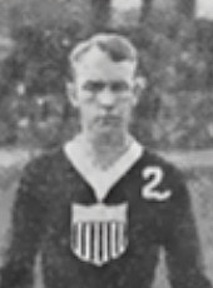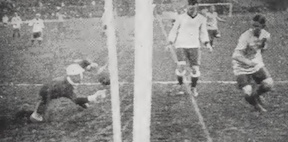
Sport: Soccer
Born: February 24, 1892
Died: January 14, 1975
Town: Harrison, New Jersey
George Joseph Tintle was born February 24, 1892 in Harrison, NJ to James and Jennie Tintle. His birth date is sometimes given as December 24th. George’s father was a machine operator in a lumber yard. Growing up in the cradle of New Jersey soccer, George found his niche as a goalkeeper. Blonde-haired and blue-eyed, he was big and quick, with a combination of anticipation and fearlessness that served him well as he sharpened his skills playing against experienced adults. George contributed to the family’s expenses by working in a shade factory as soon as he was able, but moved into more exciting work later on with the Harrison Fired Department.
George began his professional career at the age of 16 with Harrison’s Alley Boys Football Club, which was notable for its exclusive use of native-born players. He was their primary goalkeeper into his early 20s, when he began commanding a bigger salary for better clubs. In 1916, he was in goal for the US during a 3–2 win over Sweden and a 1–1 tie with Norway.

George returned to Europe in another uniform in 1917 as a member of the 29th Infantry in France during World War I. He and Bow Ford, a soccer star from nearby Kearny, survived the Meuse-Argonne offensive, during which more than 5,000 enlisted men in the division were killed or wounded. George returned to America in time to sign with the Bethlehem Steel team for its tour of Scandinavia in 1919. Ford also played on the tour. He made a third playing excursion to Scandinavia in 1920 with the St. Louis All-Americans, helping them go 7–2–5. So admired was George by the Swedish players that they actually requested that he be added to the visiting team.
George picked up where he left off as a fireman and in pro soccer, playing for four more years with his hometown team, Erie AA, which changed its name to Harrison SC when it became a founding club in the American Soccer League. George was in goal for a pair of New Jersey Cup championships, in 1920 and 1922. The club played its home games in the old Federal League baseball stadium, Peps Park, which had hosted the National Challenge Cup final while George was in the army.
George retired as a player at 30 and took a job coaching soccer at Harrison High School, while continuing to work as a firefighter. His teams lost only a handful of games and produced seven undefeated seasons. In 1952, George was a member of the Olympic Selection Committee and was also enshrined in the National Soccer Hall of Fame. By then he had risen to the rank of captain in the Harrison FD.
George lived and worked in Paterson for the rest of his life and passed away there in 1975.